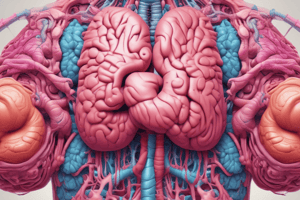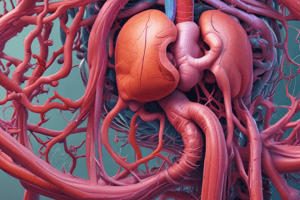Podcast
Questions and Answers
Which of the following organs produces saliva, which contains the enzyme amylase to break down carbohydrates?
Which of the following organs produces saliva, which contains the enzyme amylase to break down carbohydrates?
- Tongue
- Teeth
- Esophagus
- Salivary glands (correct)
What is the primary role of the tongue in the digestive system?
What is the primary role of the tongue in the digestive system?
- To sense the taste and texture of food (correct)
- To grind and break down food mechanically
- To produce saliva for swallowing
- To move food from the mouth to the esophagus
What is the primary function of the esophagus in the digestive system?
What is the primary function of the esophagus in the digestive system?
- To absorb nutrients from the food
- To produce enzymes for the digestion of food
- To grind and break down food mechanically
- To move food safely from the mouth to the stomach (correct)
Which of the following organs in the digestive system is responsible for the mechanical breakdown of food through biting and grinding?
Which of the following organs in the digestive system is responsible for the mechanical breakdown of food through biting and grinding?
What type of movement is responsible for pushing food along the esophagus towards the stomach?
What type of movement is responsible for pushing food along the esophagus towards the stomach?
Which of the following organs in the digestive system is responsible for both ingesting and digesting food?
Which of the following organs in the digestive system is responsible for both ingesting and digesting food?
Which organ is responsible for further breaking down food using strong acids and enzymes?
Which organ is responsible for further breaking down food using strong acids and enzymes?
What is the primary function of the liver and gallbladder in the digestive system?
What is the primary function of the liver and gallbladder in the digestive system?
Which part of the small intestine is responsible for the majority of nutrient absorption?
Which part of the small intestine is responsible for the majority of nutrient absorption?
What is the primary function of the large intestine?
What is the primary function of the large intestine?
Which organ is responsible for accumulating and expelling fecal matter from the body?
Which organ is responsible for accumulating and expelling fecal matter from the body?
What is the opening at the end of the gastrointestinal tract through which waste products exit the body?
What is the opening at the end of the gastrointestinal tract through which waste products exit the body?
Study Notes
An Overview of the Organs Involved in the Human Digestive System
The human digestive system is a complex network of organs and glands responsible for ingesting, digesting, absorbing, and excreting food. While there might be some confusion regarding terminologies and locations due to multiple sources providing slightly different descriptions, the general consensus remains that several organs play crucial roles in this process. Here, we aim to clarify the organs involved in the digestive system and discuss their respective functions:
Mouth and Oral Cavity
The mouth is the primary site for ingestion and digestion. It contains the tongue, salivary glands, and teeth. The tongue helps in mechanical processing of food by compression, abrasion, and distortion, while also performing sensory analysis through taste and texture perception. The salivary glands produce saliva, which lubricates food for easier swallowing and contains amylase, an enzyme that starts the breakdown of carbohydrates. The teeth play a significant role in the mechanical breakdown of food through biting and grinding.
Esophagus
The esophagus is a muscular tube leading from the mouth to the stomach. Its primary function is to move food safely from the mouth to the stomach without hindering breathing. Peristaltic movements push food along the esophagus towards the stomach.
Stomach
Located immediately below the esophagus, the stomach is a J-shaped organ responsible for further breaking down food using strong acids and enzymes called pepsin. It also mixes food with hydrochloric acid, creating a highly acidic environment that facilitates protein digestion and kills potential pathogens. After the stomach's action, food is transformed into a semi-solid substance called chyme.
Liver and Gallbladder
The liver and gallbladder play vital roles in the digestive system. The liver produces bile, which is stored in the gallbladder until needed. Bile emulsifies fats, making them more accessible to digestive enzymes. When food reaches the lower part of the small intestine, the gallbladder contracts to release bile into the small intestine through the bile ducts.
Small Intestine
The small intestine is the longest part of the digestive tract and is responsible for the majority of nutrient absorption. It contains the duodenum, jejunum, and ileum. The walls of the small intestine are lined with tiny finger-like projections called villi, which dramatically increase the surface area for maximum nutrient absorption. Enzymes produced by the pancreas and bile from the liver and gallbladder break down complex molecules into simpler ones that can be absorbed across the intestinal wall. Once absorbed, these nutrients are sent to the liver for processing before entering the bloodstream.
Large Intestine
The large intestine, also known as the colon, is responsible for reabsorbing water and electrolytes back into the body. The remaining indigestible food residue, now referred to as feces, is compacted and pushed towards the anus.
Rectum and Anus
The rectum is a short, relatively straight part of the large intestine where fecal matter accumulates before being expelled through the anal canal. The anus is the opening at the end of the gastrointestinal tract, through which waste products, in the form of stool, exit the body.
Studying That Suits You
Use AI to generate personalized quizzes and flashcards to suit your learning preferences.
Description
Test your knowledge about the organs involved in the human digestive system - from the mouth and esophagus to the liver, gallbladder, small intestine, large intestine, rectum, and anus. Understand the functions of each organ in the digestion process.




